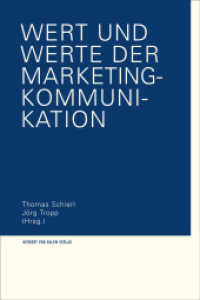Full Description
This book presents current understanding of the importance of modern immunology in the etiopathogenesis of human diseases and explores how this understanding is impacting on diagnosis, prognosis, treatment, and prophylaxis. As the core of modern immunology, the "danger/injury model" is introduced and addressed throughout the book. Volume I of the book describes the network of damage-associated molecular pattern molecules (DAMPs) and examines the central role of DAMPs in cellular stress responses and associated regulated cell death, the promotion and resolution of inflammation, the activation of innate lymphoid cells and unconventional T cells, the stimulation of adaptive immunity, and tissue repair. The significance of DAMPs in a wide range of human diseases will then be explored in Volume II of the book, with discussion of the implications of injury-induced innate immunity for present and future treatments. This book is written for professionals from all medical and paramedical disciplines who are interested in the introduction of innovative data from immunity and inflammation research into clinical practice. The readership will include practitioners and clinicians such as hematologists, rheumatologists, traumatologists, oncologists, intensive care anesthetists, endocrinologists such as diabetologists, psychiatrists, neurologists, pharmacists, and transplantologists.
Contents
Part I. The Three Major Paradigms in Modern Immunology.- Prologue: The Term "Immunity" over the Course of Time.- The Three Major Paradigms in Immunology.- Epilogue: What Major Paradigm in Immunology Comes Next?.- Part II. The Innate Immune System: an Organ of Perception Determined to Maintain Homeostasis.- Prologue: The Guardians of Homeostasis.- Innate Immune Recognition Molecules.- Epilogue: The Innate Immune System: a Global Player in Health and Disease.- Part III. The Whole Family of Mammalian Innate Immune Cells.- Prologue: The Whole Body as an Immune System?.- Mobile Innate Immune Cells.- Sessile Innate Immune Cells.- Epilogue: The Whole Body as an Immune Defence System.- Part IV. The World of DAMPs. Prologue: About DAMPs, PAMPs and MAMPs.- Endogenous DAMPs, Category I: Constitutively Expressed Native Molecules (Cat. I DAMPs).- Endogenous DAMPs, Category II: Constitutively Expressed, Injury-Modified Molecules (Cat. II DAMPs).- Endogenous DAMPs, Category III: Inducible DAMPs (Cat. III DAMPs).- Exogenous DAMPs, Category IV (Cat. IV DAMPs).- Epilogue: The Well-Dosed Work of DAMPs in their Commission to Restore and Maintain Homeostasis.- Part V. Cellular Stress Responses and Regulated Cell Death.- Prologue: Innate Immune Tools to Defend against Stressful Injury: Success and Failure.- Cell-Autonomous (Cell-Intrinsic) Stress Responses.- Regulated Cell Death.- Epilogue: The Horror of an Injury-Induced Avalanche of DAMPs.- Part VI. Innate Immune Effector Responses.- Prologue: The Various Facets of Innate Immune Effector Responses.- Cellular Inflammatory Responses.- Humoral Innate Immune Effector Responses.- Regulation of Innate Inflammatory Responses.- Epilogue to Part VI.- Part VII. Function of Innate Lymphoid Cells and Unconventional T Cells with Partial Innate Function.- Prologue: The "Ready-to-Go" Lymphocytes of the Immune System.- Activating and Function of Innate Lymphoid Cells.- Activating and Function of Unconventional T Cells.- Epilogue: Killer Lymphocytes as Tools for Future Immunotherapeutic Approaches.- Part VIII. DAMPs Promoting Adaptive Immunity and Tissue Repair.- Prologue: The "Long Arm" of DAMPs in Shaping Adaptive Immune Responses and Tissue Repairing Processes.- Antigen Uptake, Processing and Presentation by Dendritic Cells.- Antigen in the Presence of DAMPs Induces Immunostimulatory Dendritic Cells to Promote "Destructive" Acquired Immune Responses.- Antigen in the Absence of DAMPs Promotes Immunotolerance: the Role of Dendritic Cells and Regulatory T Cells.- An Impressive Example of Peripheral Tolerance against Nonself: Tolerance to Commensal Bacterial and Dietary Protein Antigens.- Immunometabolism of Dendritic Cells and T Cells.- Role of DAMPs in Tissue Regeneration and Repair.- Epilogue: DAMPs as Key Players in the Pathogenesis of Many Human Diseases.








